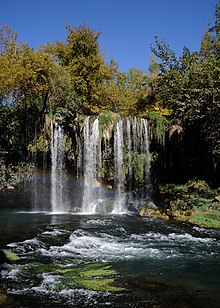
Antalya
Antalya (Turkish pronunciation: [anˈtalja] ⓘ) is the fifth-most populous city in Turkey and the capital of Antalya Province.[2] Recognized as the "capital of tourism" in Turkey and a pivotal part of the Turkish Riviera,[3] Antalya sits on Anatolia's southwest coast, flanked by the Taurus Mountains. With over 2.6 million people in its metropolitan area, it is the largest city in Turkey's Mediterranean Region, situated along the Mediterranean Sea.[4][5][6]
Not to be confused with Antakya, Anatolia, or Antaliya.
Antalya
Metropolitan municipality
20,591 km2 (7,950 sq mi)
1,417 km2 (547 sq mi)
30 m (100 ft)
1,344,000
2,619,832
122/km2 (320/sq mi)
Antalyalı
(+90) 242
07
The city that is now Antalya was first settled around 200 BC by the Attalid dynasty of Pergamon, which was soon conquered by the Romans. Roman rule saw Antalya thrive, including the construction of several new monuments, such as Hadrian's Gate, and the flourishing of nearby ancient cities such as Patara, Xanthos and Myra in the Lycia region; Perga, Aspendos and Side in Pamphylia; and Sagalassos, Antioch and Termessos in Pisidia. These cities were already significant centers before Roman influence. Antalya has changed hands several times, including to the Seljuk Empire in 1207 and an expanding Ottoman Empire in 1391.[7] Ottoman rule brought relative peace and stability for the next five hundred years. The city was occupied by Italy for three years in the aftermath of World War I, but was recaptured by a newly independent Turkey in the Turkish War of Independence.
While the city itself only has modest elevation changes, Antalya has high mountains in all directions to its interior. With moisture being trapped, the local climate thus has high winter rainfall, while the interior bay setting result in very hot summers for a coastal city.
The city is Turkey's biggest international sea resort on the Turkish Riviera. Large-scale development and governmental funding has made it a prime destination for tourists. Antalya is currently the fourth-most visited city in the world, trailing behind only Istanbul, London, and Dubai, attracting more than 16.5 million foreign visitors in 2023.[8][9]
Etymology[edit]
The city was founded as "Attaleia" (Ancient Greek: Ἀττάλεια), named after its founder Attalos II, king of Pergamon.[10] This name, still in use in Greek, was later evolved in Turkish as Adalia and then Antalya.[11] Attaleia was also the name of a festival at Delphi and Attalis (Greek: Ἀτταλίς) was the name of an old Greek tribe at Athens.[12][13] Despite the close similarity, there is no connection with the name Anatolia.
Education[edit]
Akdeniz University enrolls over 60,000 students and 4,000 academic and administrative staff.[61]
